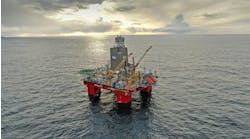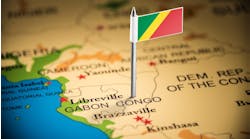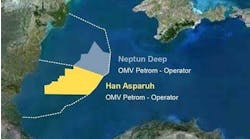The Yme field was discovered by Statoil in 1987. The field is located on block 9/2, halfway between Stavanger and Ekofisk and is isolated from the existing North Sea infrastructure. The water depth is 85-95 meters.
Production from the field started in February 1996 using the modified jackup Mærsk Giant and the FSO tanker Polysaga. By July 1999, the field had produced a total of 6 million cu meters of oil.
Yme ranks as one of the smallest fields off Norway with independent production facilities, and is the first Statoil development where the installations are owned and operated by external contractors.
Maersk Contractors Norge is responsible for operating the jackup, while Rasmussen Maritime Services has the management of the FSO tanker Polysaga. Five wells were drilled from the jackup to enable oil to be produced from the Gamma structure. Additional wells have been drilled to re-inject produced water and surplus gas.
The Beta East structure is produced through two wells. These were drilled through a subsea template located about 12 km from Gamma. The oil flows via two subsea pipelines to the jackup for processing.
Polysaga has a storage capacity of up to 160,000 cu meters of oil. It is moored and loaded by the turret loading system (STL). The oil from Polysaga is offloaded into a shuttle tanker and transported to the Statoil Mongstad terminal near Bergen for final processing and fiscal metering.
Field development
The Yme field has been developed in three phases: development of Gamma, development of Beta East, and exploration and development of the adjacent prospects. The decision to develop Yme was based only on the recoverable reserves in the Gamma structure.
In 1993, the Gamma structure was estimated to contain 19 million cu meters of oil (oil in place). The reserve estimate was based on only one exploration well and 3D-seismic, and held a high degree of uncertainty. The recoverable oil was estimated to be 3.5 million cu meters and the production period was estimated to be 28 months.
In addition, an exploration well in Beta East had indicated "oil shows." It was considered possible that recoverable oil was trapped higher in the structure. The upside potential for Beta East and its adjacent prospects were uncertain.
Technical challenge
The heavy oil column requires some form of artificial lift to maintain production from the wells and deplete the reservoir. The alternatives were gaslift or electrical submerged pumps (ESPs). The isolated location prevented use of an existing infrastructure for gas disposal. Export of produced gas was not viable. The gas volume was, however, limited due to low gas oil ratio (GOR).
Most oil producing platforms are complex facilities, including oil/water separation to meet sales specifications. The low volume of Yme crude would barely pay back investment costs of new production facilities.
It was decided to evaluate the use of a modified drilling rig and/or oil tanker for development of Yme. A simplified process would be used for oil production. ESPs were to be used for artificial lift. Functional requirement instead of technical specification would be used as the basis for conversion of the existing facilities. To reduce the economical exposure, the installation should be leased and operated by external contractors.
Several alternative solutions were evaluated. These were grouped into four main solutions, each with their own sub-solutions. The four main solutions were:
- Jackup production and drilling platform connected to a floating storage unit by a 2.5 km flexible pipeline
- Jackup production and drilling platform combined with a concrete wellhead and storage platform (GBS)
- Semisubmersible production and drilling platform combined with subsea wellhead and connected to a floating storage unit
- Production ship combined with either subsea or jacked wellhead.
The use of an existing onshore terminal for final water settling and fiscal metering was evaluated. The concept was to reduce the overall offshore production facilities. A jackup platform with tensioned risers to the wellhead was deemed the most cost-effective solution on the assumption that a technically capable rig could be identified at a cost-effective rate.
Development strategy
It was decided to reduce the uncertainty with respect to the reservoir and the cost of the modified jack-up before submitting the final plan for development and operation (PDO). A combined appraisal and production well could be used to reduce the reservoir uncertainty.
Following a market evaluation, Maersk Contractors was selected for detailed negotiations. An agreement was reached subject to confirmation of the appraisal well and the PDO-approval. The "commercial statement" and a preliminary PDO were submitted to the authorities in December 1993, subject to reservoir confirmation by the appraisal well.
Drilling was completed in March 1994, and the updated PDO was submitted to the authorities in October 1994. The strategy for contracting a floating storage unit, mooring system, and pipelines was established, and after a bidding and evaluation period, a contract was awarded during the winter of 1994. This work progressed in parallel with the final clarification of the contract for the jackup.
PDO update
The appraisal well resulted in an increase in the estimated volume of oil in place volume - from 19 million cu meters to 26 million cu meters. In addition, the reservoir properties were found to be better than previously assessed. This resulted in a production strategy, which incorporated water injection. The estimated recoverable oil volume increased from 3.5 million cu meters to 5.8 million cu meters. Expected "field lifetime" was increased to 44 months, from 28 months.
Utilization of the Mongstad terminal for final water settling and fiscal metering was found attractive and included in the plan. The simplified separation facilities enabled gas compression facilities to be installed for re-injecting the excess gas (instead of flaring).
These measures also made it possible to increase the oil production to 8,000 cm/d. This increased capacity allowed for development of phase 2 and 3 in parallel. The gaslift capacity was selected to enable development of Beta East. The following contracts were awarded in January 1995:
- Leasing of Mærsk Giant including production facilities
- Leasing of FSO tanker Polysaga
- Delivery of riser tension system - ABB
- Leasing of ESP - Centrilift
- Delivery of STL mooring system.
Production from Yme field started in February 1996, only 13 months after contract award and PDO approval.
Modification
The harsh environment jackup Mærsk Giant was chosen for the project due to its size and its ability to carry the extra load in addition to the normal drilling loads. Calculations were performed, which included the installation of eight production risers, each with 150 tons tension and the 1,200 tons weight of the production equipment.
The calculations confirmed that the unit had sufficient holding capacity but due to the increased storm loading, special skirts had to be fitted under the spudcans. The skirts increased the fixity between the spudcan and the seabed and thereby reduced the stresses in the legs.
Mærsk Giant was modified at Verolme Botlek in Rotterdam. The production facilities and a new control room were installed. The aft preload tank was converted to a wellhead area. Skirts were fitted on the spudcans and additional active and passive fire protection was installed. The production facilities have the following capacities:
Oil production: 8,000 cm/d
Water production: 4,000 cm/d
Gas injection: 400,000 cm/d
Gaslift: 400,000 cm/d
Water injection: 6,000 cu meters
Power generation: 12 MW
Wellhead: 8 slots
The water content of the oil exported to the storage tanker should be less than 5% basic sediment and water (BS&W).
The system consists of a 2,500-meter flexible pipeline, 7.5 in. in diameter. The pipeline was delivered by Coflexip and installed between Mærsk Giant and the FSO tanker Polysaga. The STL (Submerged Turret Loading) buoy was moored with eight anchor lines using suction anchors.
Polysaga was modified at Astilleros in Cadiz. The upgrade included installation of STL facility, installation of helideck, offshore crane, cargo export system, upgrade control room and installation of active and passive fire protection system.
Phase 2, Beta East
Oil reserves at Yme Beta East were confirmed by an appraisal well in June 1995. The "commercial statement" and PDO were submitted to authorities in September and approved in November 1995. Beta East increased the recoverable oil volume from 5.8 million cu meters to 10.5 million cu meters. This extended the field's lifetime from 44 months to 67 months.
The development of Beta East consists of a three-slot HOST template, through which two subsea wells have been drilled. Equipment was delivered by Kongsberg Offshore Services (KOS) and installed through the moonpool of a semisubmersible drilling rig.
Production makes use of gaslift for artificial lift. Two parallel 8-in. pipes are used for production and one 5-in. pipe is used for gaslift. These were installed during the spring of 1996 by Stolt Comex Seaway. Production from Beta East started in June 1996, only 7 months after PDO approval.
Phase 3, prospects
Gamma Southeast was discovered and put into production using a combined exploration and production well. This was drilled from Mærsk Giant in February 1997. The prospect Epsilon was dry. The exploration well which was drilled from Mærsk Giant in January 1998 has been converted to a gas disposal injection well.
Beta West North was discovered in the summer of 1997. The combined exploration and production well was drilled through the remaining slot on the Beta template. PDO was approved in the spring of 1999. Production is planned to start in the late summer of 1999.
In addition, a combined exploration and production well will be drilled into Beta West South. If this proves to be a new discovery, the well will be put into production late autumn 1999. This well will be connected as a satellite to the existing Beta infrastructure.
If the well is dry, a new side-track will be drilled as a second production well in Beta West North. The expected volume of oil in place in Beta West North is 15 million cu meters. The recoverable volume is 2.6 million cu meters.
The prospect Beta West South has a 50% probability of oil discovery. The expected volume of oil in place is 10 million cu meters. Recoverable volume is expected to be approx. 1.5 million cu meters. The upside potential in Beta West is significant. If the structure Beta West North and South should be filled to spill point, the oil in place could be 65 million cu meters.
Summary
What through the early discussions for field development was only an extended well testing plant, grew through reservoir information into a full process train, and has become one of the most efficient and cost-effective means of marginal field development.
The Yme field has been producing since February 1996 and has been recognized as a great success. The project incorporates a number of new features within oil production from the North Sea. The main benefits are:
- Short time (13 months) from contract award and PDO approval to first oil
- Fast track conversion and installation of the unit
- Low cost of a production/drilling unit compared to that of a platform
- Efficiency of production and water/gas reinjection
- Low CAPEX and OPEX of the unit.
The success and positive economic results of the jackup drilling and production unit Mærsk Giant is expected to result in greater utilization of the concept for marginal field developments in the future. The contractor operated field has also been successful in satisfying the requirements from authorities with respect to technical compliance as well as operation and safety performance.


